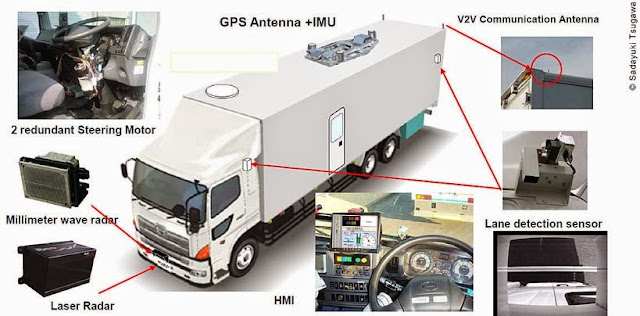 |
| Platooning: Two trucks follow a lead driver in a semiautonomous convoy from Stuttgart to Rotterdam. |
As
reported by Bloomberg:
Michael Kropp typically spends his days behind the wheel of a big, freight-hauling truck, navigating the high-speed curves, offramps, and stop-and-go traffic typical of European highways. On a recent trip to Rotterdam, he was able to relax and take in the sights. Kropp was one of about 30 drivers participating in a test of a new automated driving technology called platooning, which links trucks via Wi-Fi, GPS, sensors, and cameras so they can travel semi-autonomously behind one another. The leading rig dictates speed and direction, while the rest automatically steer, accelerate, and brake in a closely spaced convoy. “It was a little eerie to hand over part of my role as driver,” says Kropp, a 55-year-old test driver for Daimler who piloted the second vehicle in the caravan. “But it was really comfortable, especially in heavy traffic or boring stretches of road.”
Although driverless cars grab headlines, it may take decades before truly autonomous vehicles rule the road. In the meantime, semiautomated convoys can help manufacturers hone the technology while cutting emissions and fuel consumption, says Anders Kellström, who managed Volvo’s test run to Rotterdam. “Platooning is one of the first steps toward automated driving,” he says. “The technology is mature.”

Drivers will still be needed—by law they’ll have to keep their hands on the wheel. But letting the rig do some of the work will result in less passing, quicker braking, and fuel savings of about 10 percent for the following trucks and a smaller gain for the lead vehicle, according to Daimler. And it will help reduce congestion. When a human is at the wheel, a truck in some countries must maintain a distance of about half a football field from the vehicle in front of it to stop safely in an emergency. With automation, that distance shrinks to about 50 feet. “Traffic on the whole will become calmer,” says Andreas Renschler, who heads the Scania and MAN truck brands for Volkswagen.

Manufacturers expect platooning to start taking off in 2020. Most trucks made in the past decade have sensors that alert drivers when they wander out of a lane or get too close to the vehicle ahead of them, relying on cameras and radar similar to those found in high-end Mercedes-Benz and BMW sedans. Adding automated steering and braking wouldn’t be complicated, vehicle makers say. Lori Tavasszy, a logistics professor at Delft University of Technology in the Netherlands, says half the European fleet of big rigs—750,000 trucks—could be platoon-ready by 2025. “The technology for this is there,” says Erik Jonnaert, secretary general of the European Automobile Manufacturers’ Association. “The bottleneck is regulation and how it can be deployed commercially so freight companies pick it up.”
In Brussels, lawmakers are considering Europewide regulations for things such as the minimum legal distance between vehicles—164 feet in Germany, but simply “a safe distance” in the Netherlands—and adopting standard rules about dissolving platoons at busy highway junctions. On April 14 transport ministers, the European Commission, and industry representatives agreed to cooperate on connected and automated driving, focusing on traffic rules and making testing easier. Close cooperation “is needed if we want a wide-scale introduction of platooning,” says Harrie Schippers, who heads DAF Trucks, the European unit of Paccar, a manufacturer based near Seattle.

In April’s dry run, six convoys of two or three trucks each—including Kropp’s—traveled to Rotterdam from Sweden, Germany, and Belgium. Three Scania trucks covered the longest distance, starting near Stockholm, crossing the 10-mile Oresund Bridge and tunnel to Denmark, heading south to Germany and then into the Netherlands. Each caravan in the test completed the journey as a unit, but manufacturers envision convoys forming on an ad hoc basis, with drivers following a leader for anywhere from a few exits to hundreds of miles as individual vehicles pull off to make deliveries or take alternate routes to their final destinations. Daimler says cars seeking to leave the highway can effectively nudge their way into a convoy: The truck behind recognizes the interloper and increases its distance accordingly, then closes the gap once the car exits. If a vehicle pulls out in front of the first truck, the lead driver hits the brakes and the followers begin to slow almost immediately.

Even though the initiative started in Europe, the manufacturers say platooning may be even more relevant in places with wide-open roads such as Australia or the western U.S., where distances traveled are greater. “The event in Rotterdam really broke the ice,” says Odile Arbeit de Chalendar, an official of the Conference of European Directors of Roads, who helped set up the April test. “For the first time, we put platoons on the road, in real traffic, across borders, and long distance.”



No comments:
Post a Comment